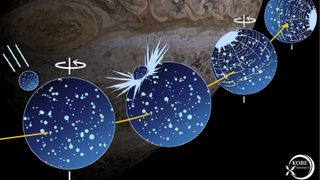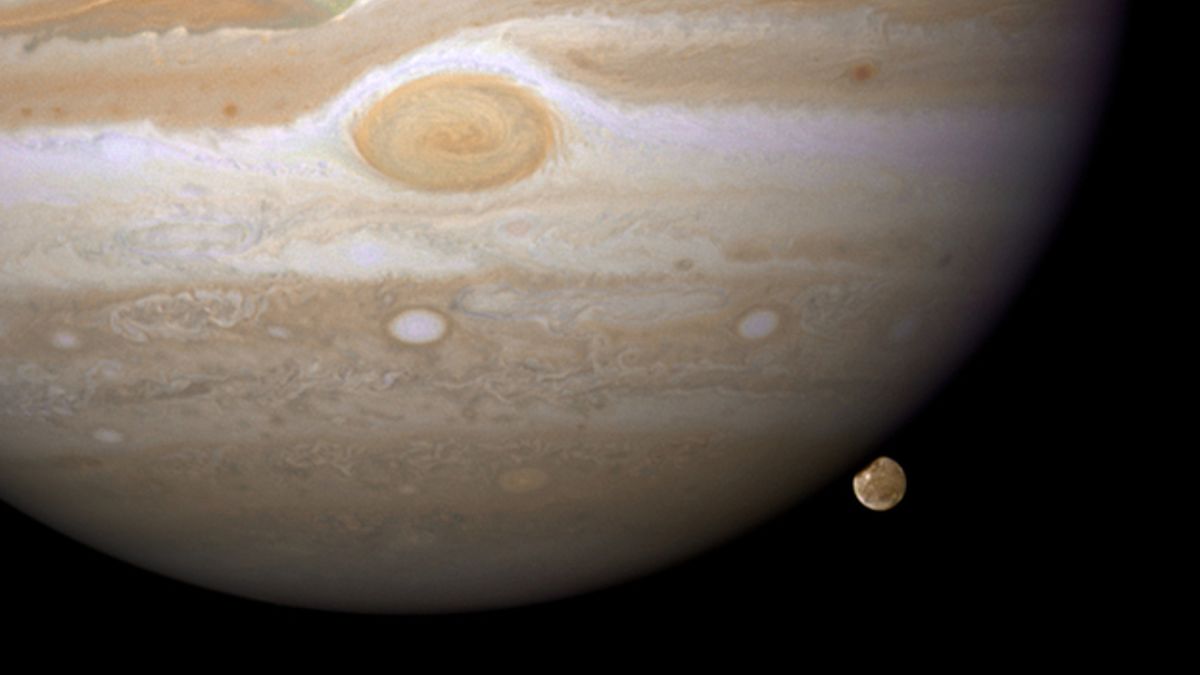Around 4 billion years ago, an enormous asteroid that was at least 10 times larger than the space rock that wiped out the dinosaurs smashed into Jupiter’s massive icy moon, Ganymede. The cataclysmic collision was so devastating it created the largest impact crater in the solar system and knocked the supersized satellite off its axis, new simulations show.
Ganymede is Jupiter‘s third-closest major moon, orbiting the gas giant roughly once every seven days. It has a diameter of 3,270 miles (5,260 kilometers), according to NASA, making it the most massive of the solar system’s many moons and larger than the planet Mercury. Just like Earth’s moon, Ganymede is tidally locked, meaning the same side constantly faces Jupiter’s swirling, storm-covered surface. Researchers believe the moon has a roughly 60-mile-deep (100 km) ocean hidden far below its icy surface.
In the 1980s, researchers discovered that large parts of the moon’s surface were covered with concentric rings of narrow trenches, or furrows, surrounding the remains of what looked like a large impact crater on Ganymede’s far side (the side facing away from Jupiter). Photos from subsequent visiting spacecraft, such as NASA’s New Horizons probe, revealed the moon’s scarred surface is the likely result of a massive asteroid collision that occurred around 600 million years after the solar system formed.
In the new study, published Sept. 3 in the journal Scientific Reports, researcher Naoyuki Hirata — an astronomer and planetary scientist at Kobe University in Japan — reconstructed Ganymede’s ancient asteroid impact using computer simulations based on the moon’s furrows. This enabled Hirata to precisely calculate the size of the rock that smashed into Ganymede for the first time. The simulations also showed how the impact likely knocked the moon off its original axis.
Related: The 10 weirdest moons in the solar system
Hirata estimated that the initial impact crater was up to 1,000 miles (1,600 km) wide, making it 10 times wider than Earth’s largest impact structure — the Vredefort Crater in South Africa. This means Ganymede’s crater was the largest known impact crater in the solar system’s history. However, it did not remain this size for long as debris from the event quickly fell back to the moon’s surface and filled in most of the hole, Hirata wrote.
Based on the size of the crater, Hirata estimates the asteroid responsible for birthing it would have been around 93 miles (150 kilometers wide) — or about as long as the state of Delaware. That would make it somewhere between 10 and 15 times larger than the Chicxulub meteor, which slammed into what is now Mexico around 66 million years ago and wiped out up to 80% of animal species on Earth, including all non-avian dinosaurs.
Some media outlets have quoted a Kobe University news release reporting that the asteroid was up to 20 times larger than the Chicxulub meteor. However, this does not align with the numbers shared in the new study.

The simulations also revealed how the impact shifted Ganymede’s tidal axis away from its rotational axis, making it tilt relative to Juptier. Earth’s polar axis was tilted in a similar way around 4.5 billion years ago when a Mars-size protoplanet, named Theia, smashed into our planet and created the moon. This is why we have different seasons throughout the year.
Interestingly, the simulations showed that regardless of where the asteroid struck Ganymede’s surface, the impact crater would always end up in the same spot on the moon’s far side from Jupiter thanks to the gravitational effects of the debris ejected into space by the collision.
The new findings help fill in details about an important chapter in Ganymede’s history. However, they also raise new questions about how this impact altered the evolution of the Jovian moon and its insides — especially its supposed subsurface ocean.
“The giant impact must have had a significant impact on the early evolution of Ganymede, but the thermal and structural effects of the impact on the interior of Ganymede have not yet been investigated at all,” Hirata said in a statement. Further research is needed to address this, he added.
The answers to Hirata’s questions could come in 2034 when the European Space Agency’s Jupiter Icy Moons Explorer (JUICE) probe is due to carry out a close flyby of Ganymede. The state-of-the-art probe was launched in April 2023 and completed the first of three planned slingshot maneuvers around the Earth-moon system on Aug. 21. The spacecraft will arrive at Jupiter in 2031.


